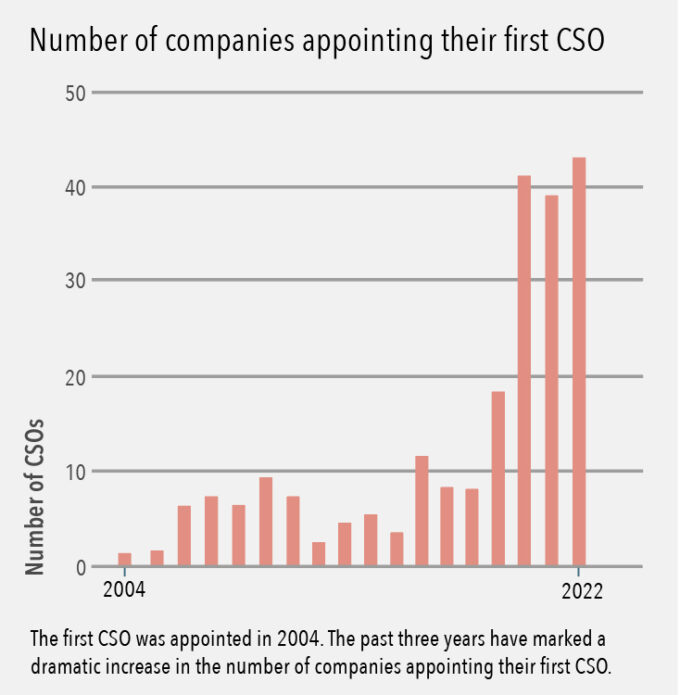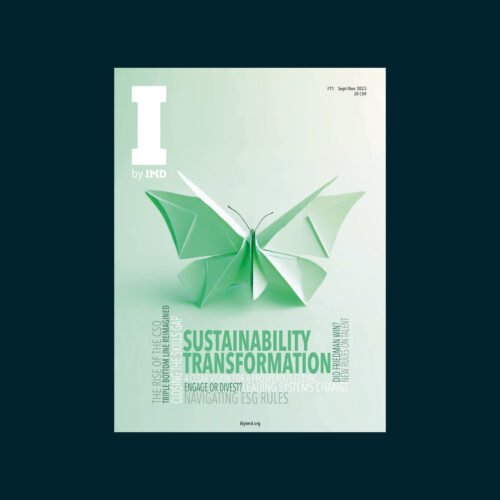While on paper CSRD initially affects about 50,000 large or listed companies, it will also require detailed reporting for companies within their supply chains. In addition, the International Sustainability Standards Board has issued two new disclosure standards meant to serve as a global baseline with a broader geographical reach.
To comply with CSRD, larger firms have the resources to set up cross-functional project teams, including colleagues from finance, legal, human resources, health and safety, strategy, internal control, IT, and risk management. Smaller firms, however, often struggle with leaner teams trying to manage the shift.
Still, while the importance of sustainability has grown, there can be confusion around the scope of sustainability-related roles and the ideal organizational design. While more CSOs are being appointed and the topic is reaching the C-suite, the distribution of responsibilities across the organization can create competition for resources, miscommunication, and duplication.
It is helpful to take note of reporting lines to better understand a firm’s commitment, maturity, and potential to succeed in its transformation. For example, 42% of CSOs or heads of sustainability report to the CEO, according to a Gartner survey of 175 executives. Additionally, 34% of heads of ESG report to the CEO. Those reporting lines can indicate to investors that the firm prioritizes sustainability, since the leader will be shaping core strategy. Reporting to a general council or to the communications lead indicates more of a compliance or reputation-building focus.
To be sure, there isn’t one ideal model. The organizational structure depends on the maturity of the firm’s sustainability strategy and how embedded it is in the core business. Firms need to design a structure that harnesses the data and insights needed to develop an informed strategy and to create accountability. Thus, getting the talent equation right is essential.
Five factors for sustainability leadership
Regardless of what organizational structure is chosen, our research with sustainability leaders across industries highlights five skills and competencies that are sought by companies seeking to position themselves at the forefront of sustainability strategy.
1. Define strategy
CSOs must define a comprehensive and forward-thinking strategy that goes beyond compliance by analyzing the company’s environmental, social, and economic impacts – setting clear goals and establishing a roadmap to achieve these objectives. The CSO must align the sustainability strategy with overall business goals to ensure a holistic and integrated approach. This involves identifying potential risks and opportunities, developing sustainable business models, and incorporating ESG factors into investment decisions. By integrating sustainability into the core business strategy, companies can drive innovation, enhance brand reputation, and gain a competitive edge.
2. Bridge the knowing-doing gap
One of the critical roles of a CSO is to bridge the knowing-doing gap within the organization. They need to ensure that the sustainability strategy is effectively implemented throughout the company and translated into language that allows employees at all levels to understand their roles in contributing to the objectives. This requires effective communication, education, and the establishment of processes that embed sustainability principles into day-to-day operations.
3. Engage and influence stakeholders
Successful sustainability efforts rely heavily on collaboration and engagement with a diverse range of stakeholders, both internal and external. Rising societal demands and regulatory risk mean major groups of stakeholders – including potential employees and investors – are paying attention. Losing focus means alienating one or more of these groups. CSOs must possess strong communication and relationship-building skills and tap into their passion to engage with employees, investors, customers, suppliers, communities, NGOs, and governmental entities. Internally, the CSO works to foster a culture of sustainability, creating awareness and driving behavioral change, and attracting and retaining talent seeking purpose. Externally, they engage with customers, suppliers, NGOs, and governments to establish collaborative networks and advocate for sustainable practices across the value chain. This requires resilience, as they often work through influence rather than authority, to foster shared understanding, support, and alignment.
4. Drive innovation
The ability to drive innovation amid ambiguity is crucial for CSOs to identify new and creative approaches to complex sustainability challenges. This entails staying informed about emerging technologies, industry best practices, and global trends that can enhance sustainability performance. The CSO needs to foster a culture of continuous improvement and open-mindedness to embrace innovative solutions and adapt to evolving demands.
5. Measure and demonstrate impact
Measuring and reporting the impact of sustainability initiatives is essential to demonstrate progress, transparency, and accountability. CSOs must have teams with expertise in data collection, analysis, and reporting to provide meaningful metrics to measure, monitor, and highlight the firm’s sustainability performance. This information enables stakeholders to assess the company’s efforts and outcomes, driving better decision-making and reinforcing the organization’s reputation and commitment to sustainability.
In the driving seat
A CSO who is empowered with the authority, resources, and support from the top can drive sustainable transformation throughout the organization. By embedding sustainability into their strategy, businesses can build resilience, mitigate risks, attract and retain employees, and foster innovation – ultimately creating value for both the company and society as a whole.
By driving sustainable business strategies, engaging stakeholders, and demonstrating impact, CSOs are leading change. These skills are also in demand for more traditional functions that are being influenced by the shifting landscape towards greater transparency and accountability. With the right talent in place, organizations that prioritize and invest in sustainability will emerge as “future ready”.

Audio available






